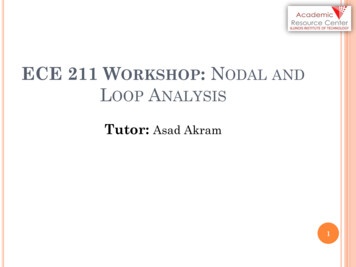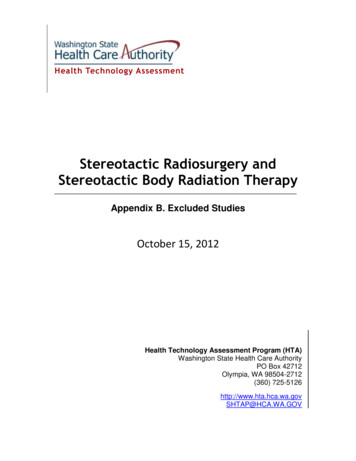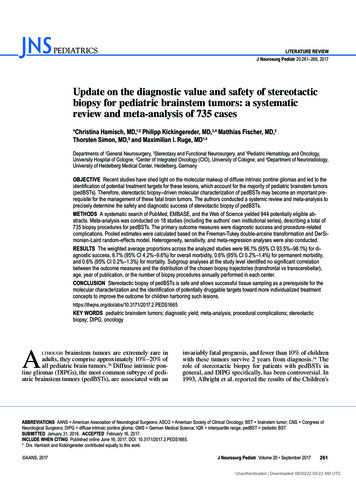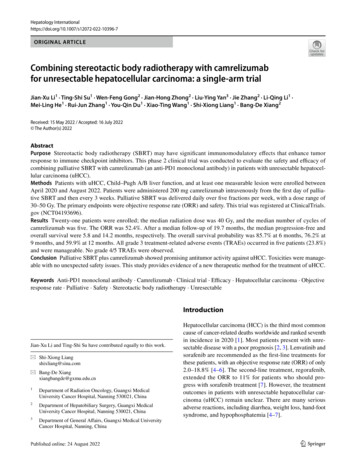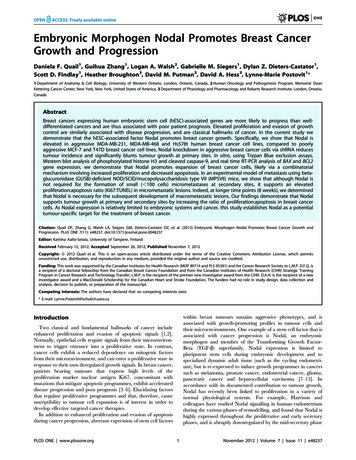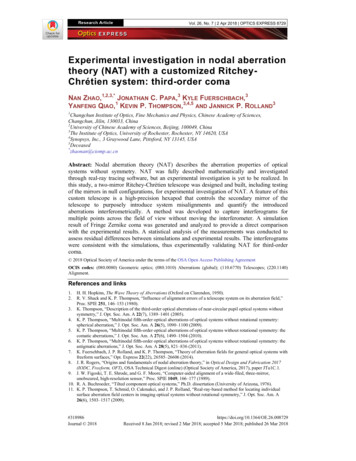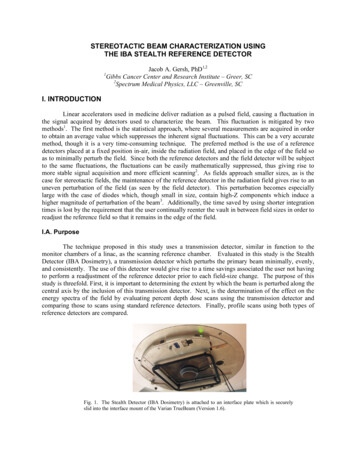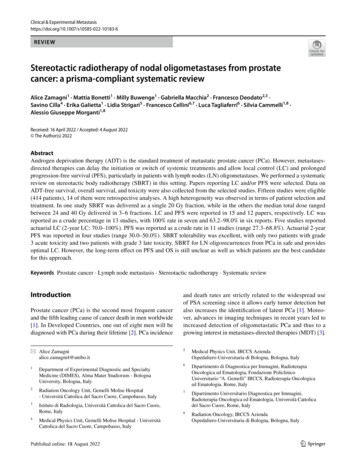
Transcription
Clinical & Experimental -6REVIEWStereotactic radiotherapy of nodal oligometastases from prostatecancer: a prisma‑compliant systematic reviewAlice Zamagni1 · Mattia Bonetti1 · Milly Buwenge1 · Gabriella Macchia2 · Francesco Deodato2,3 ·Savino Cilla4 · Erika Galietta1 · Lidia Strigari5 · Francesco Cellini6,7 · Luca Tagliaferri6 · Silvia Cammelli1,8 ·Alessio Giuseppe Morganti1,8Received: 16 April 2022 / Accepted: 4 August 2022 The Author(s) 2022AbstractAndrogen deprivation therapy (ADT) is the standard treatment of metastatic prostate cancer (PCa). However, metastasesdirected therapies can delay the initiation or switch of systemic treatments and allow local control (LC) and prolongedprogression-free survival (PFS), particularly in patients with lymph nodes (LN) oligometastases. We performed a systematicreview on stereotactic body radiotherapy (SBRT) in this setting. Papers reporting LC and/or PFS were selected. Data onADT-free survival, overall survival, and toxicity were also collected from the selected studies. Fifteen studies were eligible(414 patients), 14 of them were retrospective analyses. A high heterogeneity was observed in terms of patient selection andtreatment. In one study SBRT was delivered as a single 20 Gy fraction, while in the others the median total dose rangedbetween 24 and 40 Gy delivered in 3–6 fractions. LC and PFS were reported in 15 and 12 papers, respectively. LC wasreported as a crude percentage in 13 studies, with 100% rate in seven and 63.2–98.0% in six reports. Five studies reportedactuarial LC (2-year LC: 70.0–100%). PFS was reported as a crude rate in 11 studies (range 27.3–68.8%). Actuarial 2-yearPFS was reported in four studies (range 30.0–50.0%). SBRT tolerability was excellent, with only two patients with grade3 acute toxicity and two patients with grade 3 late toxicity. SBRT for LN oligorecurrences from PCa in safe and providesoptimal LC. However, the long-term effect on PFS and OS is still unclear as well as which patients are the best candidatefor this approach.Keywords Prostate cancer · Lymph node metastasis · Stereotactic radiotherapy · Systematic reviewIntroductionProstate cancer (PCa) is the second most frequent cancerand the fifth leading cause of cancer death in men worldwide[1]. In Developed Countries, one out of eight men will bediagnosed with PCa during their lifetime [2]. PCa incidence* Alice Zamagnialice.zamagni4@unibo.it1Department of Experimental Diagnostic and SpecialtyMedicine (DIMES), Alma Mater Studiorum - BolognaUniversity, Bologna, Italy2Radiation Oncology Unit, Gemelli Molise Hospital- Università Cattolica del Sacro Cuore, Campobasso, Italy3Istituto di Radiologia, Università Cattolica del Sacro Cuore,Rome, Italy4Medical Physics Unit, Gemelli Molise Hospital - UniversitàCattolica del Sacro Cuore, Campobasso, Italyand death rates are strictly related to the widespread useof PSA screening since it allows early tumor detection butalso increases the identification of latent PCa [1]. Moreover, advances in imaging techniques in recent years led toincreased detection of oligometastatic PCa and thus to agrowing interest in metastases-directed therapies (MDT) [3].5Medical Physics Unit, IRCCS AziendaOspedaliero-Universitaria di Bologna, Bologna, Italy6Dipartimento di Diagnostica per Immagini, RadioterapiaOncologica ed Ematologia, Fondazione PoliclinicoUniversitario “A. Gemelli” IRCCS, Radioterapia Oncologicaed Ematologia, Rome, Italy7Dipartimento Universitario Diagnostica per Immagini,Radioterapia Oncologica ed Ematologia, Università Cattolicadel Sacro Cuore, Rome, Italy8Radiation Oncology, IRCCS AziendaOspedaliero-Universitaria di Bologna, Bologna, Italy13Vol.:(0123456789)
Clinical & Experimental MetastasisThe optimal treatment in this setting is still under debatedue to a lack of strong evidence. Moreover, based on international guidelines [4, 5], the current treatment standard formetastatic PCa is still androgen deprivation therapy (ADT)( other systemic therapies), without specific indications forthe subset of oligometastatic patients. However, increasingevidence suggests that a more targeted management of oligometastatic PCa could play a role as a “curative” option in themultimodal treatment approach [6] with high local control(LC) rate and delay of systemic treatments. As a result, 75%of the Advanced Prostate Cancer Consensus Conference(APCCC, 2019) panelists recommended systemic therapyplus local treatment of all lesions for most patients with oligorecurrent PCa [7] due to better tolerability of MDT [7–11]compared to chemotherapy or ADT [12, 13].Even though publications in this setting have increased inthe last years, at least two questions are still open, namely,what is the impact of MDT on overall survival (OS) and cancer-specific survival and how to select patients suitable forthis approach. For patient stratification, following the recentclassification proposed by the European Society for Radiotherapy and Oncology (ESTRO) and Radiation TherapyOncology Group (RTOG) consensus [14], a first distinctionshould be made between synchronous and metachronousoligometastatic PCa [15, 16]. In fact, metachronous nodaloligometastases should be considered as a potentially different entity compared to bones or visceral oligometastases (orat least as a different step of disease progression) [17, 18]being lymph nodes (LN) oligometastases a favorable subsetin terms of disease progression [17, 19, 20].However, clear evidence (especially from randomizedphase III trials) in this setting is lacking. Therefore, weperformed a systematic review to summarize the availableresults on stereotactic body radiotherapy (SBRT) as MDTin nodal oligometastases from PCa.Materials and methodsThe protocol of this systematic review was submitted to thePROSPERO international prospective register of systematicreview on August 25th, 2020 [21]. The Preferred ReportingItems for Systematic Reviews and Meta-Analysis (PRISMA)guidelines were followed to perform the analysis [22]. Wesearched for articles reporting on the outcome of metachronous oligometastatic PCa patients treated with SBRT for LNmetastases. The primary objectives of the review were LCand progression-free survival (PFS). We also collected dataon the biochemical response (BRes), biochemical relapse,clinical response (CRes), androgen deprivation therapy-freesurvival (ADT-FS), OS, and toxicity when reported with atleast one of the primary endpoints.13Bibliographic searchA literature search for relevant studies was conducted inPubMed, Scopus, and Cochrane library up to July 1st,2021, using the combination of several terms like: “lymphnode”, “metastases”, “stereotactic body radiotherapy”. Theterm “prostat*” was not included in the search criteria toallow the identification of papers reporting data on mixedprimary tumors. The complete search strategy is reportedin Appendix 1. The reference list of the selected paperswas checked to eventually identify additional manuscripts.Only studies published in English were included.Inclusion criteriaWe used the Population, Intervention, Comparator, Outcome and Study design (PICOS) approach to assess studyeligibility. We included studies on PCa patients withmetachronous oligometastatic disease (synchronous oligometastatic disease diagnoses were not allowed) limited to the LN and treated with SBRT (max 10 fractions).Papers were excluded if patients were treated with SBRTas concomitant or sequential boost combined with elective nodal irradiation (ENI) or in the primary treatmentsetting (unless the latter case involved a small minority ofthe patients' cohort). Papers should report at least one ofthe two selected primary endpoints: LC or PFS (both actuarial and crude rates allowed). If available, other selectedoutcomes were collected. Studies involving also patientstreated with therapies other than SBRT were included,but only if the primary endpoints of patients treated withSBRT on LN oligometastases from PCa were separatelyreported. Moreover, studies reporting duplicated data wereexcluded and studies reporting partially duplicated datawere excluded if the outcome was not reported separatelyfor duplicated and non-duplicated data. We also excludedsystematic or narrative reviews, meta-analysis, guidelines,studies on animal models, preclinical studies, study protocols, case reports, surveys, and planning and imagingstudies.Study selectionStudies were independently screened by AZ and MBo atthe title and abstract level, and duplicate publications wereremoved. After this screening, papers considered suitablefor our analysis were examined at full-text level to selectarticles eligible for the systematic review (Appendix 2).Any discrepancies during the selection process were discussed and eventually resolved by a third author (AGM).
Clinical & Experimental MetastasisData extractionData from the selected papers were independently extractedby AZ and MBo and collected in a predefined form. In theevent of conflicting data, the final decision was discussedwith the participation of AGM. The following informationwas abstracted from the selected papers: authors, year ofpublication, reference, study design, enrollment period,number of patients, number of treated LN, patients age,imaging modality, hormonal status, PSA at recurrence,selection criteria for patients inclusion, follow-up (FU)duration, the time between primary treatment and SBRT,SBRT details (total dose, number of fraction, SBRT delivery technique), use of concomitant and/or adjuvant ADT,outcomes in term of LC, PFS, BRes, biochemical relapse,CRes, ADT-FS (both as crude and actuarial rate), and acuteand late toxicity.ResultsSearch resultsFigure 1 shows the flowchart of study selection. A total of665 studies were initially identified. After the title-abstractscreening, 55 full-text articles were examined (Appendix 2),and 15 papers were included in the final analysis. All butone were observational case series: three were prospective [23–25] and 11 were retrospective case series [26–36].The only interventional trial was a phase II study [37]. Allselected studies included only patients with metastatic PCa.Three studies reported only LC [24, 34, 35], while 12 studies reported both LC and PFS [23, 25–33, 36, 37]. Otherincluded outcomes were BRes, biochemical relapse andCRes, reported in four [27, 29, 30, 35], four [30, 32, 33, 35]and two papers [26, 32], respectively. Toxicity was reportedin nine papers [24, 25, 27–33], ADT-FS was reported inthree studies [29, 33, 35] and OS was reported in three studies [26, 31, 33]. Both toxicity and ADT-FS were reportedfor the entire cohort, including metastases other than nodal,in four studies [23–25, 34, 37].Patients and tumor characteristicsOverall, the analyzed studies included 414 patients withLN metastases plus 10 patients with both LN and bonemetastases from PCa (Table 1). Particularly, in seven studies [23–25, 31, 34, 36, 37] the patients population washeterogeneous due to the inclusion of patients with LNand/or bone metastases. In these studies, the percentageof patients with LN metastases ranged from 39.4% to85.0% (median: 63.5%). The median number of patientsper study, considering only patients with LN metastases,was 25 (range 7–94) while the median number of treatedLN per study was 34 (range 8–124). In three studies [23,25, 26] the total number of treated LN was not specified.Notably, only one study [29] reported results on more than50 patients and more than 50 lesions, while six studiesreported results on less than 20 patients [24, 27, 28, 31,36, 37].Fig. 1 Prisma flowchart describing the selction of studies13
01312/2011–03/2014RCPCRCNapieralska RCet al.,2016 [31]Pasqualettiet al.,2016 [24]NRNRRCPC12/2003–02/2008RCJereczekFossaet al.,2009 [28]Casamassimaet al.,2011 [26]JereczekFossaet al.,2012 [27]Decaes
of patients in whom ADT was prescribed before SBRT was available in two studies [3330], while in one it , was reported for the whole cohort [37]. In seven studies [27-33] ADT was prescribed concurrently with SBRT to 33.3-100% of patients. When specified, the median duration of ADT ranged between 14.5 and 17.5 months.
